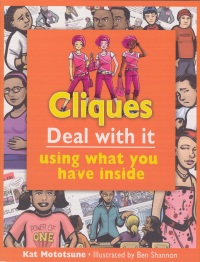| ________________
CM . . . . Volume XVII Number 24. . . .February 25th, 2011. 
 |
Cliques: Deal With It Using What You Have Inside. (Deal With It Series).
Kat Mototsune. Illustrated by Ben Shannon.
Toronto, ON: James Lorimer, 2010
32 pp., pbk., $12.95.
ISBN 978-1-55277-544-8.
Subject Headings:
Cliques (Sociology)-Juvenile literature.
Interpersonal relations-Juvenile literature.
Grades 7-9 / Ages 12-14.
Review by Gail Hamilton.
**1/2 / 4
|
| |
|

excerpt:
Itís not like being part of a clique means you spend all your time being nasty to other people or working at staying in good with the rest of the clique.
But think about it. Do you ever find yourself going along with your friends when you would rather be doing or saying what you really feel like? Do you make all your decisions based on the rules of the group? Maybe you even find that everyone in your clique looks to you to take the lead, and itís just easier to repeat the behaviour that keeps some kids in and some kids out?
Part of the "Deal with It" series designed to help young adolescents cope with conflicts and situations in their daily lives, this title consists of comic strips, quizzes, letters to a counsellor and a therapist, a double-page spread devoted to dispelling myths, doís and don'ts, and tips on how to deal with the featured concepts. "Did You Know" bands, running across the bottom of several pages, offer trivia and statistics. At the back of the book are lists of helplines, web sites, books and videos for further information. The text is written in the current kidsí language, including some slang. Illustrations are basic and cartoon-like, but quite dull and unimaginative.
Readers can determine the distinction between groups and cliques by taking a short quiz. Basically, the main difference is control, and the only difference between gangs and cliques is that gangs engage in illegal activities that are serious and often dangerous. (It is interesting to note that 96.3% of respondents in an American survey claimed that there were cliques in their school, and that 1/6 of girls have hidden their intelligence in order to gain acceptance among other students.) Other quizzes help readers to determine whether they are victims, "wannabes" or comfortable in their own skin. Some examples of questions are whether or not one has posted nasty comments about a classmate or has used text messages as a method of teasing or bullying. "Are You Mean?", yet another quiz, gets kids to take a hard look at their behaviour.
The author also provides some scenarios and asks readers to think carefully about how they would react. For example, what should you do if someone takes a photo of your friend in the gym change room and threatens to show it to all the boys? Or, what if you overhear a group of people talking about joining an online suicide club?
Students who are happy being part of a clique are unlikely to check this book out of the library. With the bookís "workbook" size, its rough paper, and the boring illustrations, it is highly unlikely that other students will check it out either. The only useful purpose the book might serve is as a discussion starter in a guidance class.
Recommended with reservations.
Gail Hamilton is a former teacher-librarian in Winnipeg, MB.

To comment on this title or this review, send mail to
cm@umanitoba.ca.
Copyright © the Manitoba Library Association. Reproduction for personal use is permitted only if this copyright notice is maintained. Any other reproduction is prohibited without permission.
NEXT REVIEW |
TABLE OF CONTENTS FOR THIS ISSUE- February 25, 2011.
AUTHORS |
TITLES |
MEDIA REVIEWS |
PROFILES |
BACK ISSUES |
SEARCH |
CMARCHIVE |
HOME |
